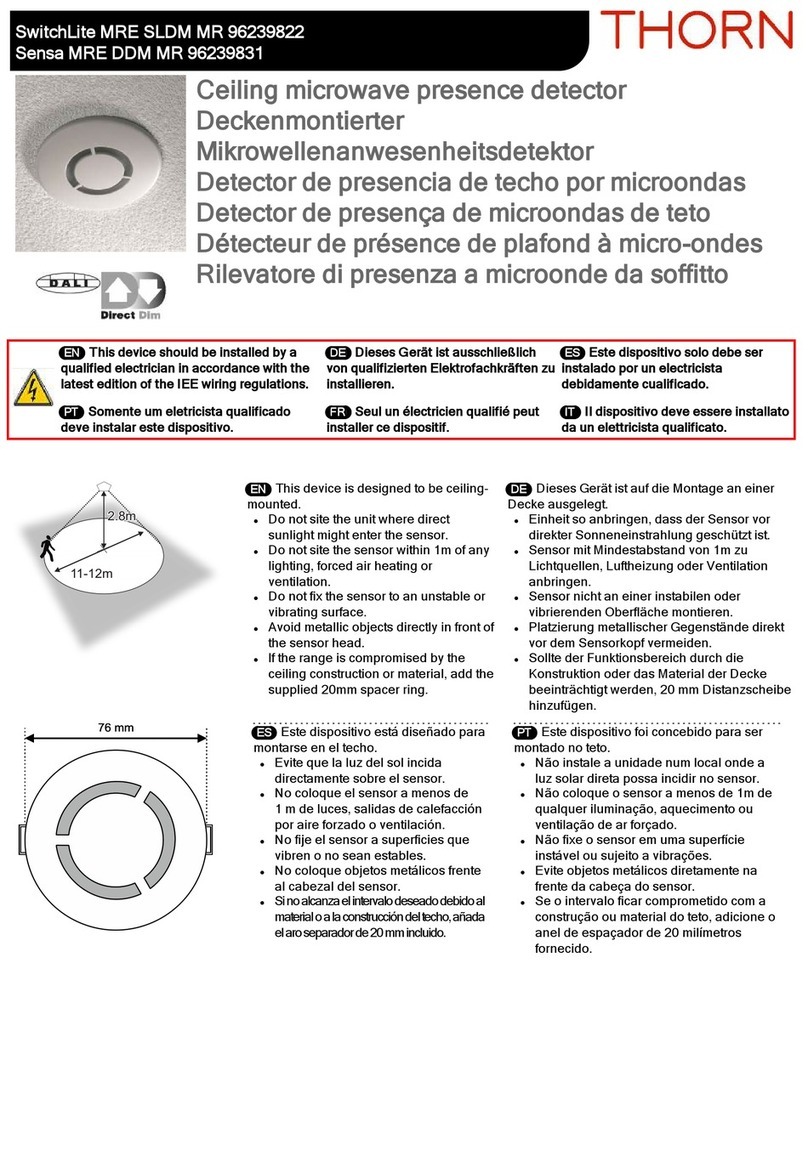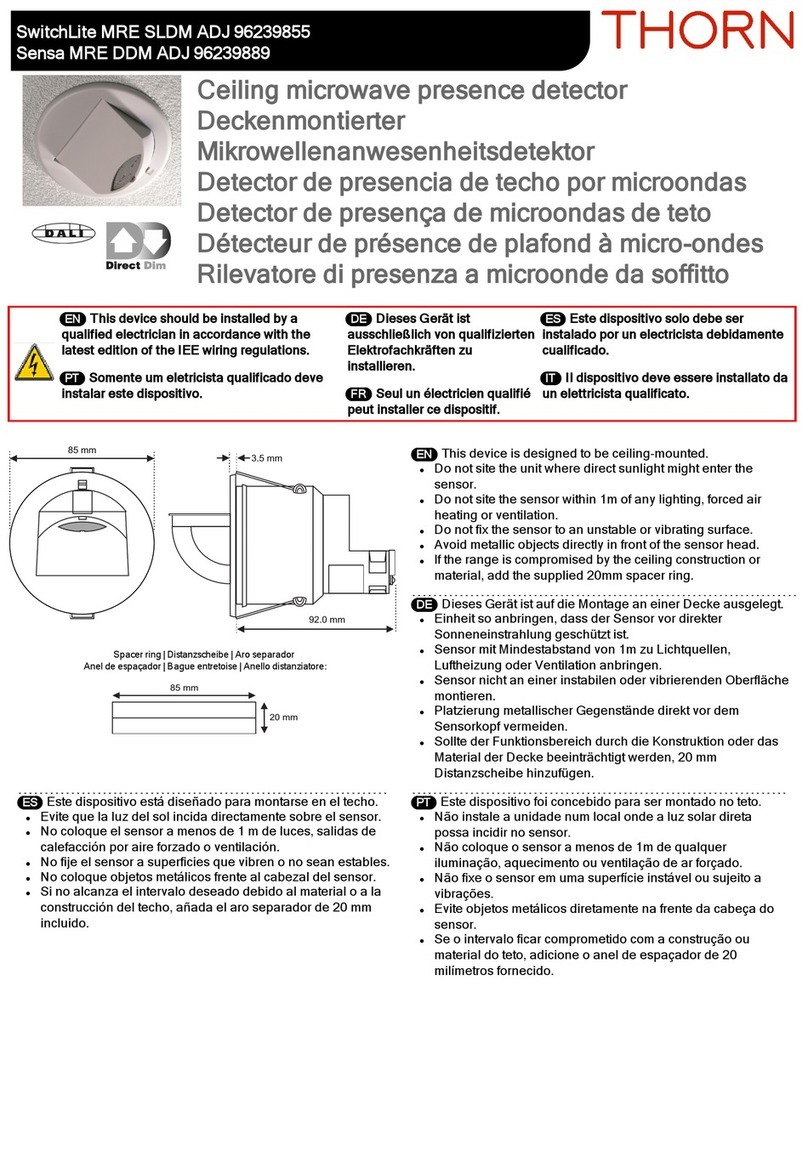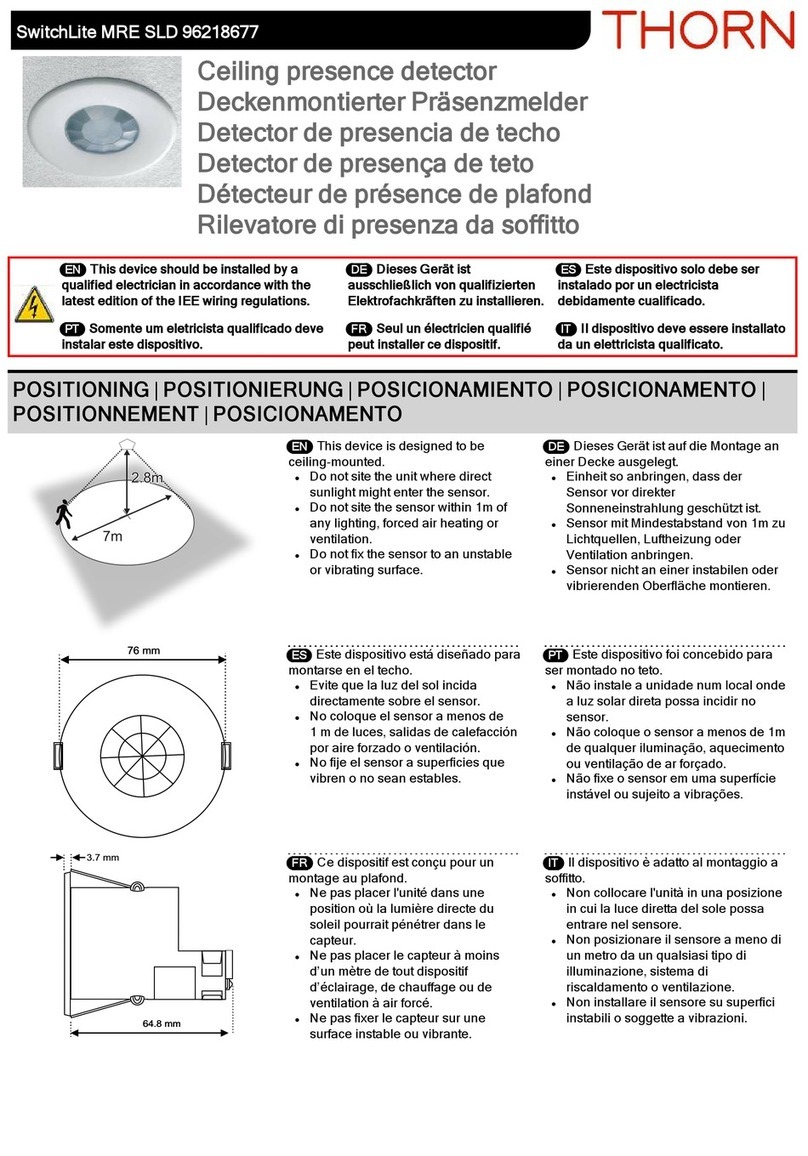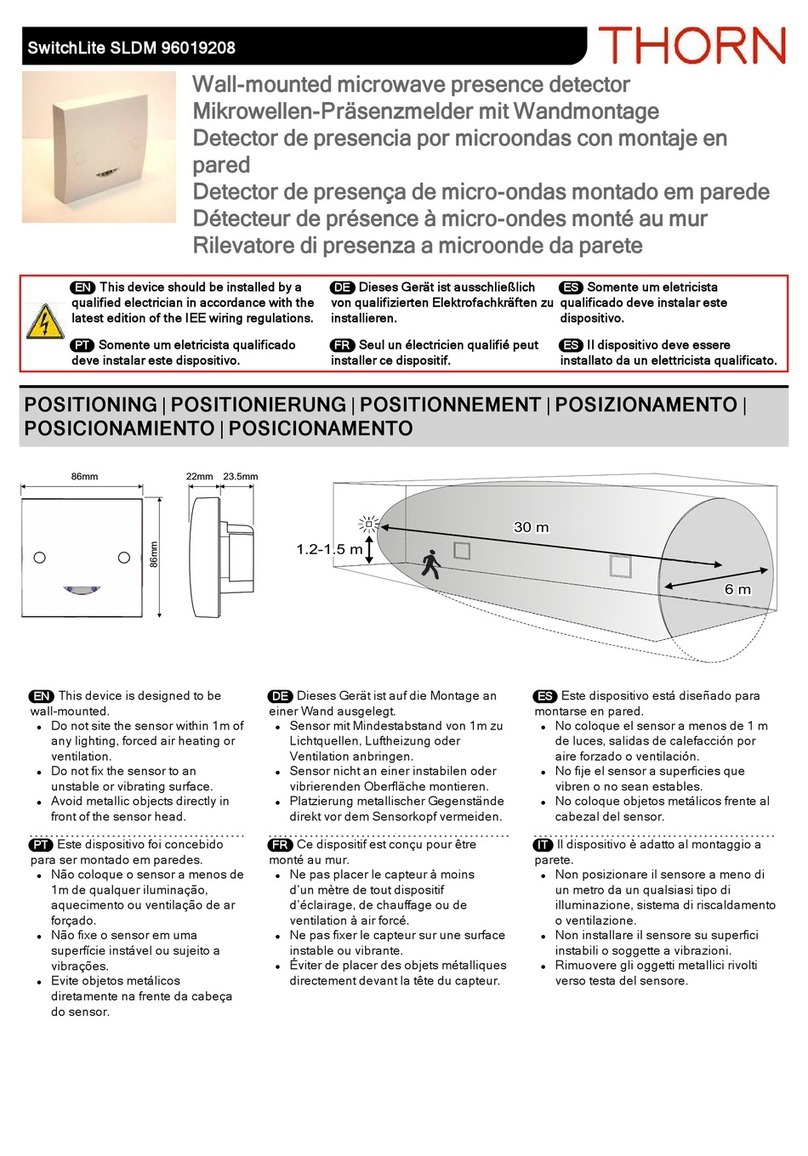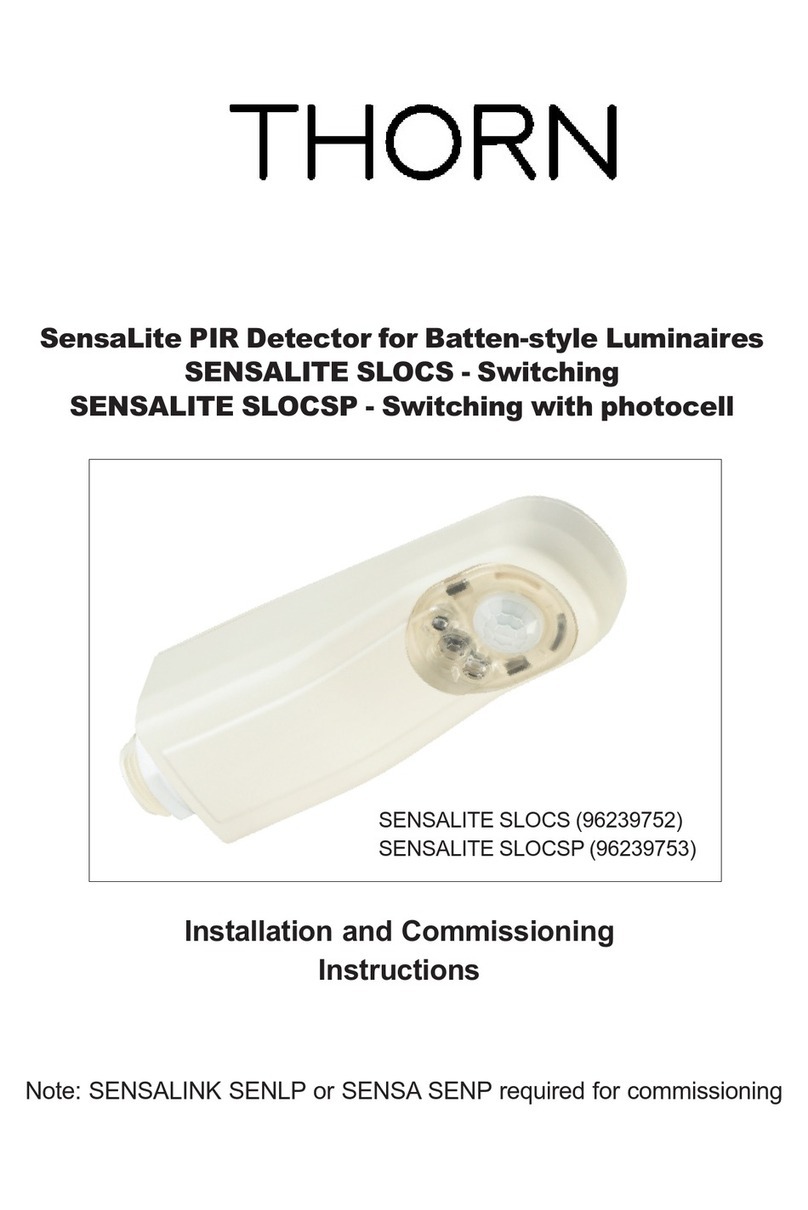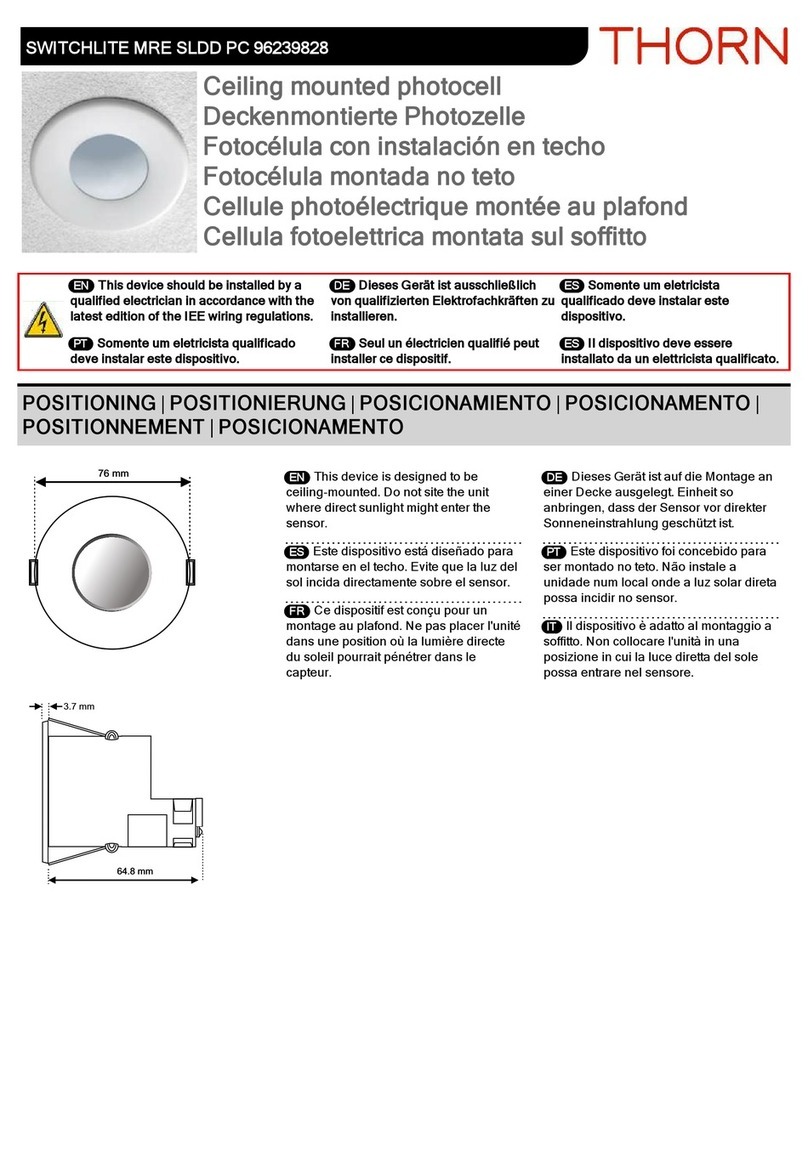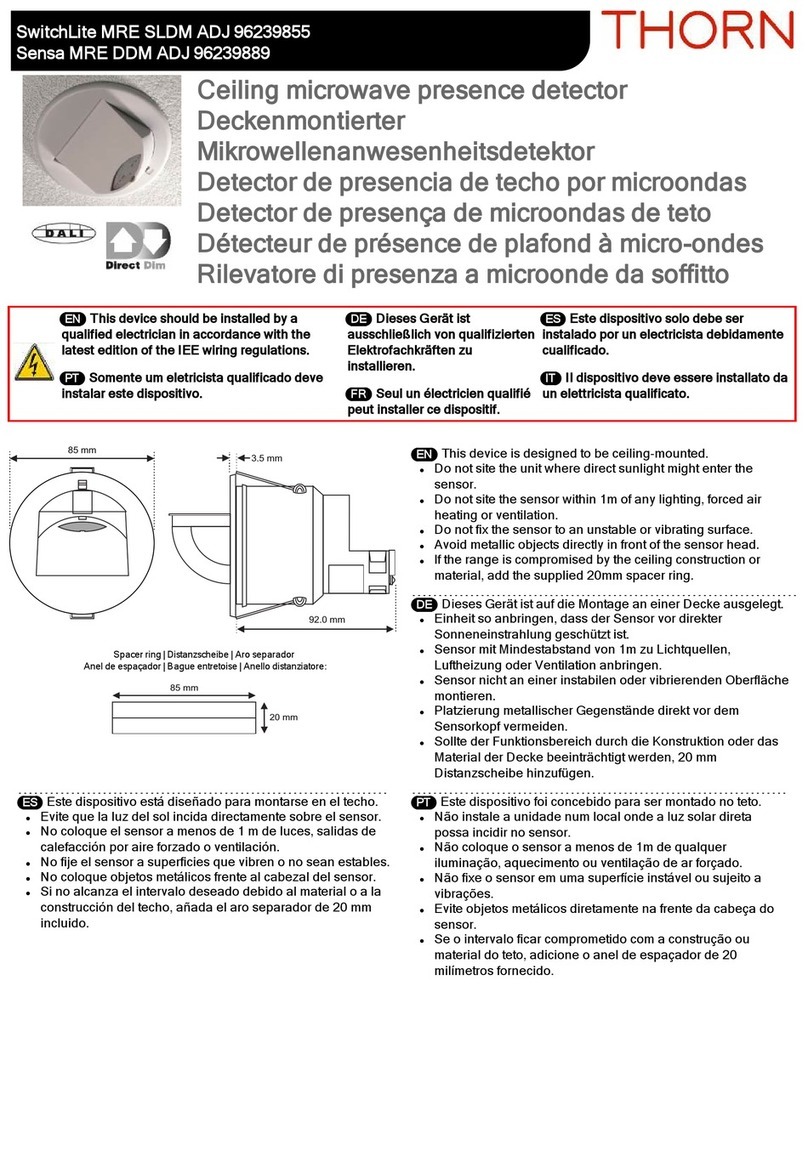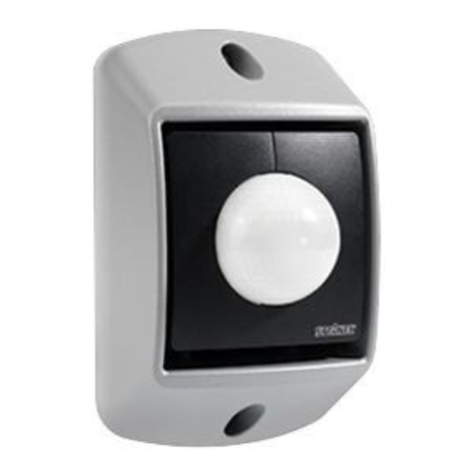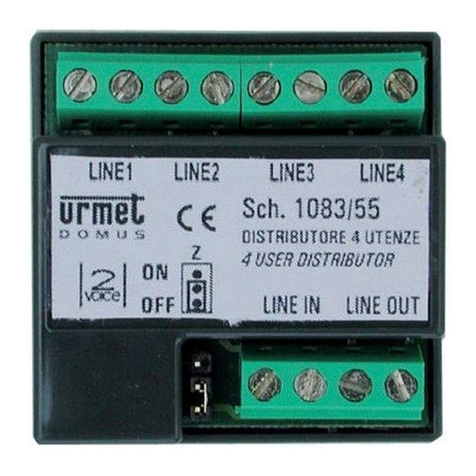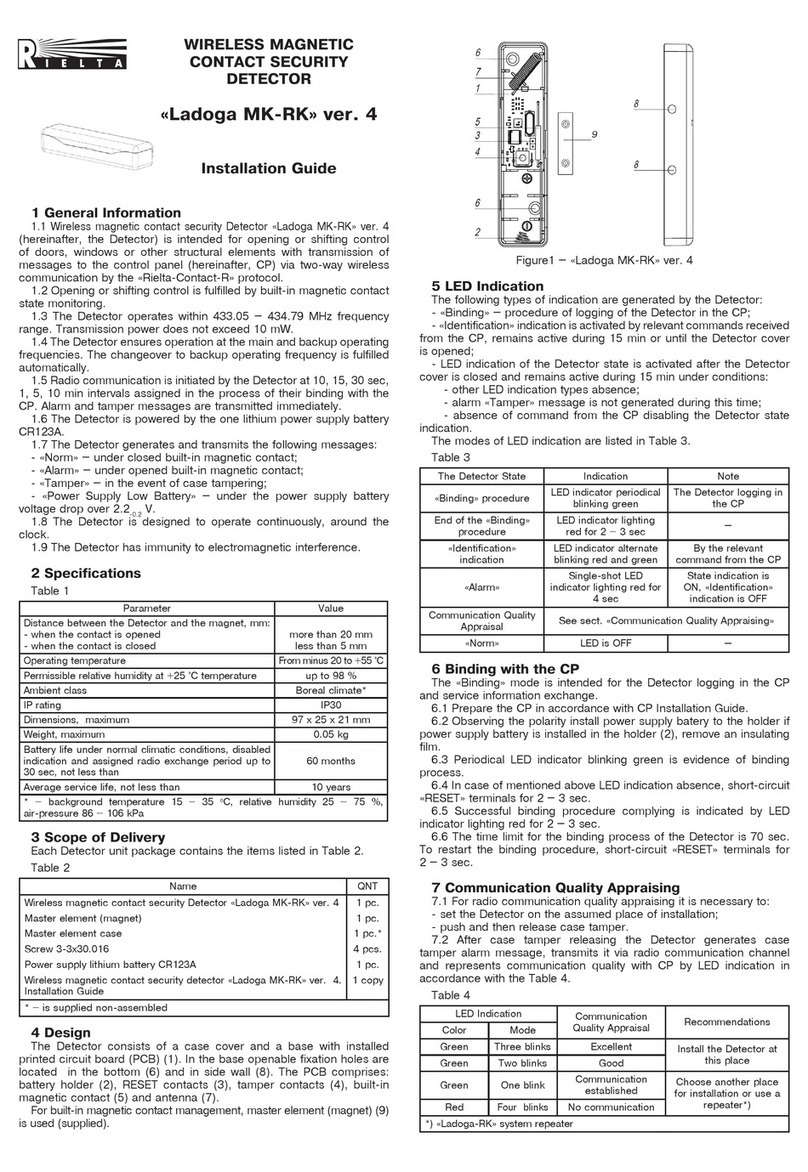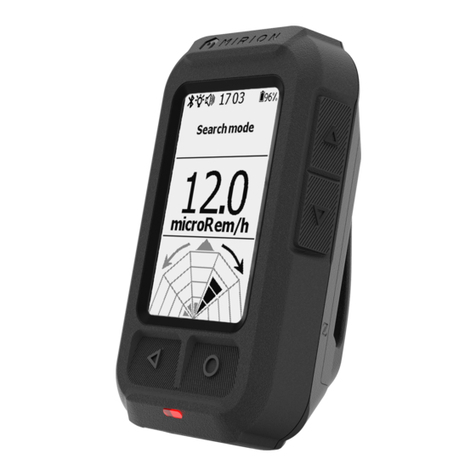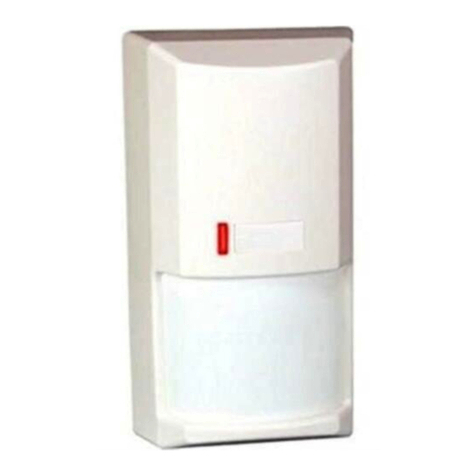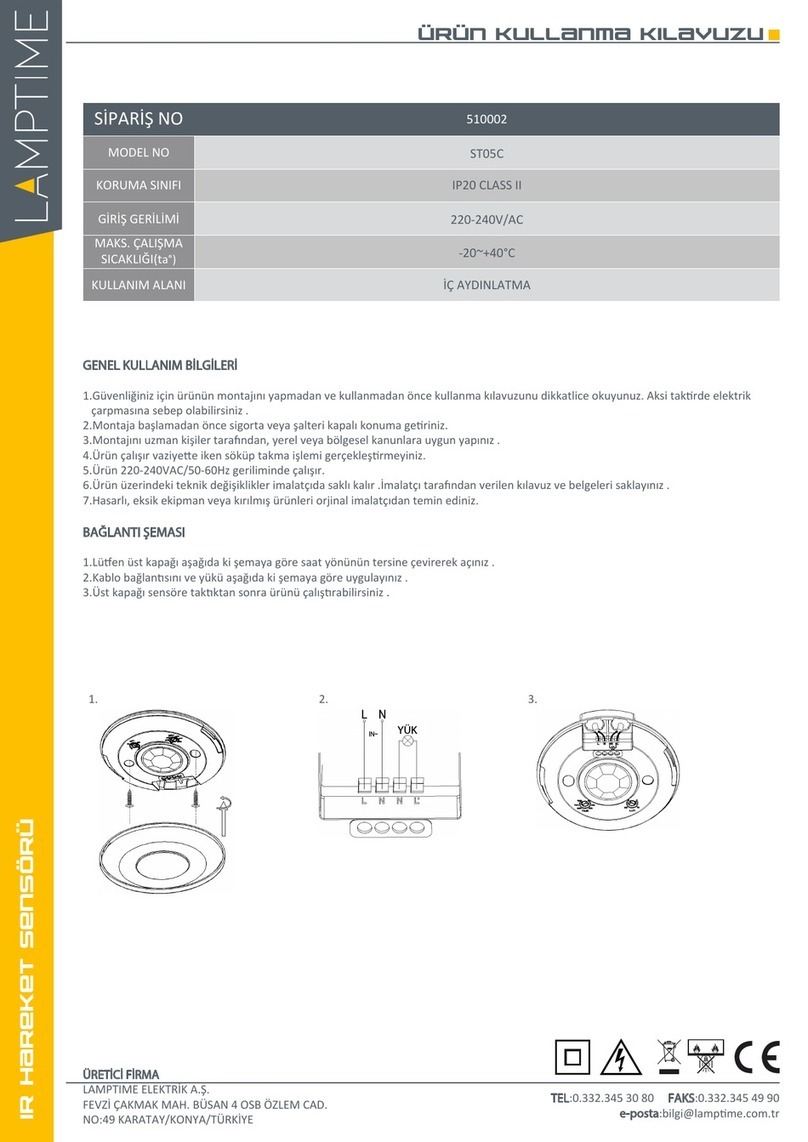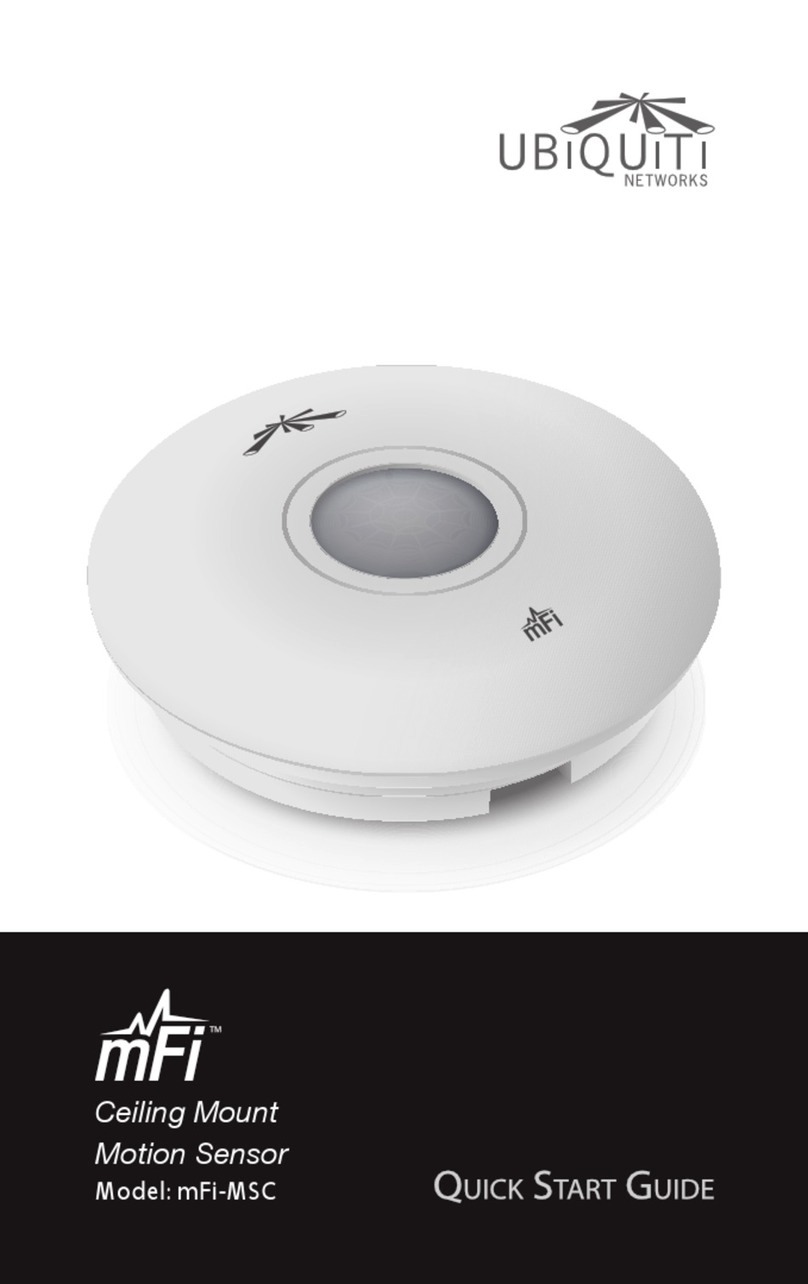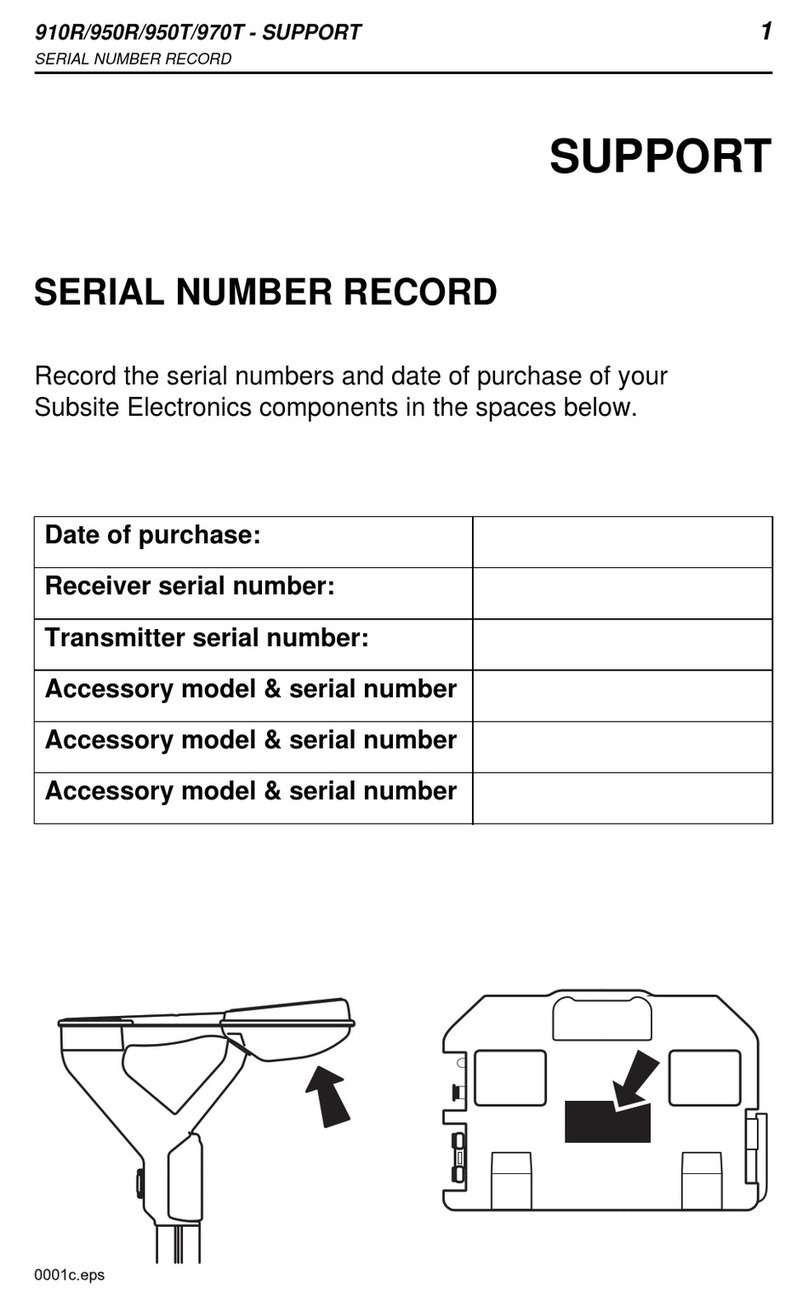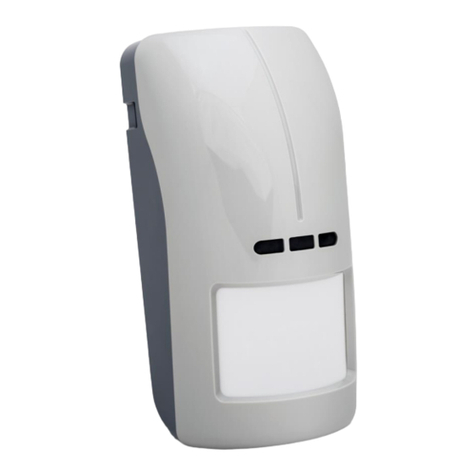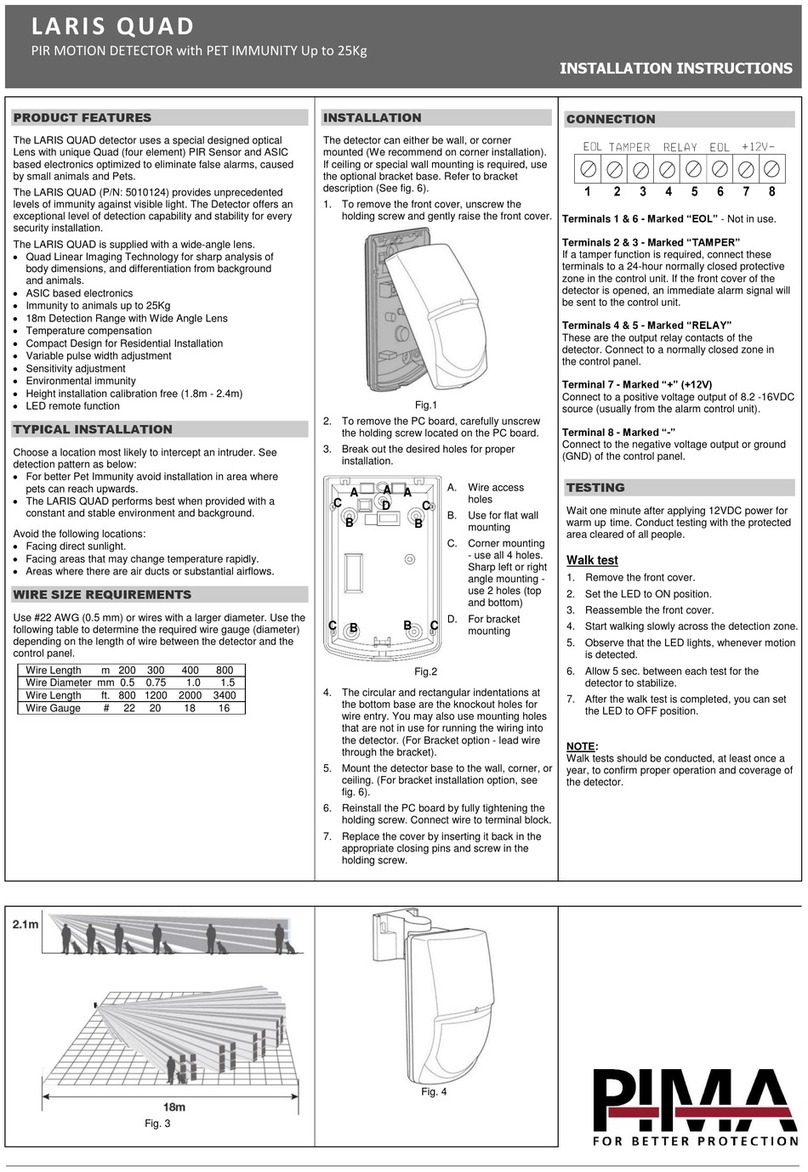
SENSA MRE SEND DSI (96211279) &
L'installation de cet équipement ne doit être confiée qu'à des personnes qualifiées.
Fixation
Le détecteur peut être encastré dans un faux-plafond d'une épaisseur maximale de 54 mm. Une distance
minimale de 125 mm est nécessaire entre la surface extérieure de la dalle du faux-plafond et le plein plafond.
Choisissez un emplacement approprié. Dans l'idéal, il doit être monté au centre de la zone contrôlé et aussi près
que possible de l'endroit où les occupants s'assoient en général.
Découpez un orifice circulaire de 50 mm de diamètre dans la dalle. Faites passer le câble et le détecteur par
l'orifice et fixez-le à l'aide de l'anneau de fixation. Si nécessaire, il suffit de faire tourner l'anneau de fixation pour
libérer le détecteur.
Note: ne pas placer à moins de 25 cm du luminaire.
Raccordement
Le détecteur est fourni avec un câble devant être connecté à l'alimentation 230 V la plus proche. Ce câble
comprend également des connexions pour la sortie numérique sans polarité (pour les connexions à l'entrée de
commande du ballast) et l'entrée de gradation T↑↓. L'entrée de gradation T↑↓ est gainée pour les applications
ne nécessitant pas cette connexion. S'il n'est pas utilisé, ce câble doit être sécurisé - ne pas raccorder à un
conducteur neutre ou à la va terre. Veuillez vous reporter ci-dessous pour plus de détails sur T↑↓.
Le contrôle d'un groupe de luminaires s'effectue à l'aide du circuit de commande numérique du détecteur.
Chaque luminaire à commander doit être doté d'un ballast à gradation numérique DSI (avec 96211279) ou DALI
(avec 96238877). Une mélange des ballasts DSI et DALI est interdit. Connectez en parallèle tous les ballasts du
groupe de commande (maximum 8) ainsi qu'à la sortie numérique sans polarité du détecteur.
Chaque luminaire est intégralement contrôlé par son entrée numérique. C'est pourquoi il doit normalement
disposer d'une alimentation électrique permanente. Toutefois, si des interrupteurs muraux manuels sont
demandés, tout ou partie des appareils d'un groupe contrôlé peuvent également être commandés de manière
traditionnelle, c'est-à-dire en coupant l'alimentation. Le circuit de commande va continuer à fonctionner
correctement même si l'alimentation secteur de certains luminaires du groupe a été coupée.
Option de gradation T↑↓
La gradation T↑ ↓ permet un contrôle local par l'utilisateur final, à l'aide d'un bouton poussoir qui peut servir à
augmenter ou diminuer le niveau d'éclairage ou à allumer/éteindre la sortie. Le bouton poussoir est raccordé
entre le conducteur sous tension et l'entrée T↑↓ du détecteur. Pour modifier le statut de sortie, il suffit d'appliquer
une courte pression sur le bouton poussoir (moins d'une seconde). Une pression plus longue permettra
d'augmenter ou diminuer le flux. Chaque pression sur le bouton poussoir modifie le sens de la gradation. Si
l'appui n'a pas duré 5 secondes, la gradation augmente (plus lumineux), à moins que le rendement ne soit déjà
supérieur à 90 %. Dans ce cas, la gradation diminue. Si la pression sur le bouton poussoir est continue et que le
flux lumineux atteint son niveau maximum, le rendement lumineux reste à ce niveau jusqu'à ce que le bouton
poussoir soit relâché. Un commutateur de verrouillage peut être connecté en parallèle afin de prendre le pas sur
le détecteur de présence (Remarque : si la gradation diminuait au départ, le flux automatiquement repartir dans
l'autre sens après avoir atteint son minimum). Plusieurs détecteurs peuvent également être connectés en
parallèle à un bouton poussoir, du moment que les détecteurs et l'interrupteur fonctionnement tous sur la même
phase.
SENSA MRE SEND DALI (96238877) Mise en service
Le paramétrage par défaut conviendra à la plupart des applications. Toutefois, l'installateur a la possibilité de
reprogrammer un large éventail de paramètres et de définir le réglage du niveau d'éclairement à l'aide de l'outil
de programmation infrarouge SENSA SENP (96004189).
Veuillez lire attentivement les instructions de fonctionnement fournies avec le programmateur avant toute
programmation.
Vous trouverez ci-dessous un tableau présentant le paramétrage par défaut ainsi qu'une explication succincte de
chaque paramètre. Ces paramètres peuvent être reprogrammés autant de fois que nécessaire. De plus, ces
paramètres sont mémorisés, en cas de coupure de l'alimentation.
W4047H
Remarques supplémentaires importantes
1. Un moyen de déconnexion doit être intégré au câblage fixé, conformément aux normes de câblage en vigueur.
2. Bien que la tension nominale de la sortie de gradation soit de 12 V, il ne s'agit pas d'une basse tension. Lors du câblage, elle
doit donc être considérée comme une tension secteur. La ligne 0V de la sortie de gradation est pratiquement en potentiel
neutre.
3. La sortie de commande de gradation doit uniquement être connectée à l'entrée de commande des ballasts et jamais aux
autres détecteurs.
4. Cet équipement ne doit être utilisé que pour contrôler des ballasts fonctionnant sur la même phase que le détecteur.
5. Étant donné que la cellule photoélectrique est montée au plafond et qu'elle est dirigée vers le bas, les mesures réalisées à
l'aide d'un luxmètre sur le plan de travail ne peuvent pas être constantes lorsque la lumière du jour éclaire différemment le
plan de travail et le plafond. C'est pourquoi les produits de ce type ne doivent être considérés que comme des produits à
même de maintenir un niveau d'éclairement APPROXIMATIF.
6. Ce produit n'allume/n'éteint pas les lampes plus souvent qu'une utilisation avec un interrupteur traditionnel. Toutefois, un
nombre maximum de cycles d'allumage/extinction est spécifié pour certains luminaires afin de connaître la durée de vie
prévue de la lampe. Veuillez vous reporter aux fiches techniques des luminaires afin de vous assurer qu'ils sont bien
compatibles avec les commandes automatiques.
Remarques
Etat du luminaire lors d'une remise sous tension (suite coupure réseau).
Mode de fonctionnement si détection de présence :
Automatique signifie que le système réagit de façon autonome.
Semi-automatique signifie que seule l'extinction est automatique lors de
l'absence de mouvements. La détection est inhibée, seule la télécommande
ou un poussoir sur l'alimentation de la cellule permet le réallumage
Période après le dernier mouvement pour déclencher l'extinction ou la gradation
du système. Mini = 10s pour test.
Niveau lumineux lors du réallumage : maxi puis décroissant ou mini puis
croissant.
OUI : Inhibition possible de la détection de présence si l'apport de lumière
naturelle est trop important. L'appareil peut s'éteindre si 125% du flux est atteint.
Si NON le niveau lumineux reste au mini du ballast.
Extinction brutale (NON). Possibilité de diminuer jusqu'à l'extinction en 80
secondes (OUI).
Possibilités :
Les lumières s'éteignent.
Le flux lumineux reste au minimum pendant 3 x la durée programmée du
"RETARDATEUR" puis se coupe.
Le flux lumineux reste au minimum jusqu'a la prochaine occupation.
L'éclairage se régule en dessous de 25% pendant 3 x la durée programmée du
"RETARDATEUR" puis se coupe.
L'éclairage se régule en dessous de 25% jusqu'à la prochaine occupation.
Paramètre
MISE SOUS
TENSION
DÉTECTEUR DE
MOUVEMENT
FONCTIONNEMENT
RETARDATEUR
DÉMARRAGE
BRILLANCE
DIMINUTION
JUSQU'À
EXTINCTION
OPTIONS À LA FIN
DU DÉLAI DU
RETARDATEUR
Options
MARCHE : allumé
ARRÊT : éteint
AUTOMATIQUE /
SEMI-AUTOMATIQU
de 5 à 35 min
AU MAXIMUM /
FAIBLE
OUI / NON
OUI / NON
AU MINIMUM /
EXTINCTION /
REGULATION <25 %
Par défaut
MARCHE
AUTOMATIQUE
20 min
AU MAXIMUM
NON
NON
EXTINCTION
Le paramétrage du niveau d'éclairement
Le niveau lumineux est réglable entre 0 et 100% du flux du luminaire. L'installateur a la possibilité de définir le
réglage du niveau d'éclairement à l'aide de l'outil de programmation infrarouge SENSA SENP (96004189) :
Réglage par les 3 boutons rouges de la télécommande.
Si OK envoi par la touche STORE.
